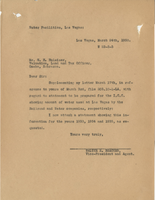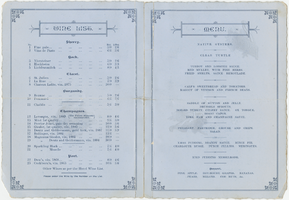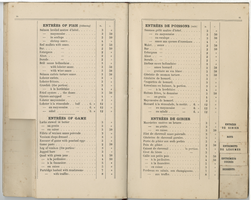Search the Special Collections and Archives Portal
Search Results
Max Velasquez oral history interview
Identifier
Abstract
Oral history interview with Max Velasquez conducted by Janice F. Hurtubise on March 08, 1981 for the Ralph Roske Oral History Project on Early Las Vegas. In this interview, Velasquez discusses his personal history as a construction worker in Las Vegas, Nevada. He describes the construction projects he worked on and the differences between 1950s construction and construction at the current time. Velasquez goes on to discuss the government regulations workers had to follow, how water pipelines were laid, and the types of equipment used in construction. Lastly, Velasquez talks about the bidding process for contractors and environmental changes in Las Vegas.
Archival Collection
Wes Davis oral history interview
Identifier
Abstract
Oral history interview with Wes Davis conducted by Dennis McBride on July 13, 2008 for the Las Vegas Gay, Lesbian, Bisexual and Transgender Archives Oral History Project. In this interview, Davis discusses the AIDS epidemic in the United States in 1981 and the effect it had on the gay community. Davis then talks about Aid for AIDS of Nevada (AFAN) in 1984, Golden Rainbow in 1986, and the Nevada Aids Project in 1987, and describes their efforts to deal with the disease. Lastly, he describes the implementation of human immunodeficiency virus (HIV) testing and explains why people were afraid to find out if they were positive for the disease.
Archival Collection

Aerial photograph of Las Vegas Wash looking northwest, June 5, 1973
Date
Archival Collection
Description
Aerial view of Las Vegas Wash at Lake Mead Blvd. and Pecos Street in North Las Vegas.
Transcribed Notes: Stamped & written on back: CNLV Engineering Dept. - Date Jun 5 1973; Project - Land use Vegas Wash - SE; Lake Mead & Pecos Flood Control in county
Image

Letter from Walter R. Bracken (Las Vegas) to W. H. Hulsizer (Omaha), March 24, 1938
Date
Archival Collection
Description
Letter from Bracken includes a chart showing water used in 1933-36 by the water company and the railroad.
Text

Transcript of interview with Della Mae Rostine by Irene Rostine, October 31, 1991
Date
Archival Collection
Description
Della Mae Rostine left Missouri with her husband, Rocco, in 1942, and headed to Las Vegas. Happy to leave behind the hard life and instability the mining industry had to offer, after living in Las Vegas for the first year the couple settled in Henderson, Nevada, known as the townsite at that time. Della Mae’s oral history provides readers with a glimpse of what life was like for the 14,000-plus individuals and families who also moved to southern Nevada during the same period in order to make a living in the growing “war work” industry the area had to offer. Della Mae shares the hardships faced in finding housing, especially for families with children. She discusses challenges ranging from securing home furnishings to purchasing groceries, including the rations on gasoline and butter at that time. Della Mae also discusses her experiences with the Basic Magnesium plant where her husband was hired as a construction worker in the early days of the plant and where she would work briefly as a machinist making shell casings and monitoring the down time on the production line. She also touches briefly on the social opportunities the BMI plant, and later Rheem Manufacturing, offered to the workers and their families. When World War II ended, more than half of residents of the townsite left, leaving fewer than 7,000 people to form what would later become the city of Henderson, Nevada. Della Mae’s oral history is a brief overview of a family life which began when BMI was just getting off the ground and continued through the many changes that took place in the BMI complex and the town site over several decades. The timing of the Rostine family’s arrival and the fact that they stayed and made a permanent home in Henderson led to their designation as one of Henderson’s “founding families.”
Text





